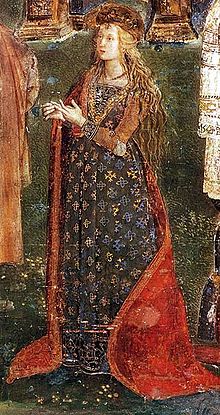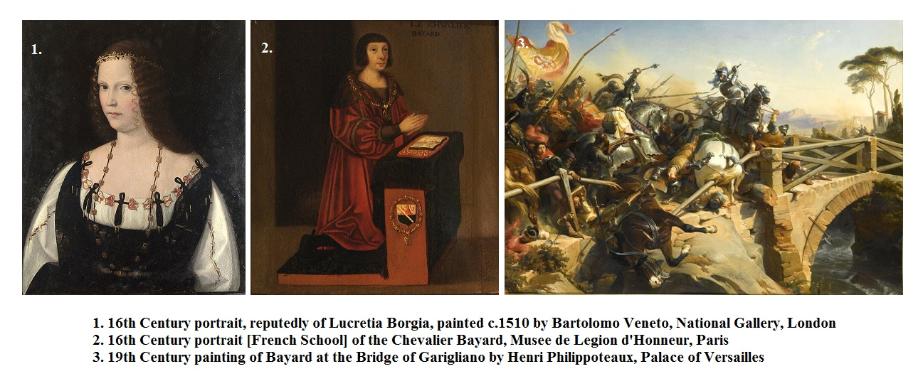
Possible portrait of Lucretia as St. Catherine of Alexandria froma fresco painted c.1494 by Pinturicchio, for the Sala dei Santi, part of the Borgia apartments in the Vatican.
ANGEL OR DEMON? MEET THE REAL LUCRETIA BORGIA
He was the ‘knight without fear or reproach’, famed as the embodiment of Renaissance chivalry. She was the illegitimate daughter of a corrupt pope who, according to legend, liked to poison her dinner guests so what happened when the Chevalier Bayard met Lucretia Borgia?
The man known to history as the Chevalier Bayard was born c.1473, at Château Bayard, in southern France, and it was inevitable that he would lead a soldier’s life. This was the time when all noblemen were expected to be skilled in the profession of arms and for two centuries every Seigneur de Bayard had died of wounds received in battle. Bayard however was destined to outshine all his illustrious forebears and even during his life he was feted as a superstar of chivalry.
Blessed with good looks and an iron constitution, Bayard was knighted at the Battle of Fornovo [1494] where he carried off an enemy standard. Though later that year he was captured, after charging into Milan in pursuit of an enemy, he was released without ransom and over the next few years he cemented his military reputation. He was wounded at Canossa [1502], single-handedly held a bridge against 200 Spaniards at Garigliano [1503] and crushed a rebellion in Genoa [1508].
All this made Bayard the most famous captain in Western Christendom and like a modern footballer he received numerous, highly lucrative offers to fight for other kings. It was his refusal to accept these offers that helped establish Bayard as the model of late medieval chivalry and he soon became known as the ‘Good Knight’. Under this soubriquet, which he himself preferred, Bayard continued to fight for the kings of France as they tried to prise the Duchy of Milan from the hands of the Hapsburg Holy Roman Emperor and his service in Italy led to his meeting with Lucretia Borgia.
As a member of the hated Borgia family, poor Lucretia’s place in the popular imagination, even during her lifetime, could hardly be more different to that of Bayard. Whereas the ‘Good Knight’ won fame and honour on the battlefield, Lucretia’s theatre of war was the marriage bed and her only function was to help her father Pope Alexander VI and her brother Cesare secure the advantageous alliances they needed to rule renaissance Italy. Lucretia was therefore married three times and her third husband was Alfonso d’Este Duke of Ferrara.
In 1510, the Duke of Ferrara asked Louis XII for military aid in his war against Pope Julius II (Alexander VI’s bitter rival and successor) and the French King was happy to send the ‘Good Knight’, along with several thousand French men-at-arms and Swiss mercenaries, to strengthen the city’s garrison. Bayard stayed in Ferrara for eight months and he soon became captivated by the Duke’s beautiful wife. A contemporary biography of Bayard, written by his ‘Loyal Servant’ Jacques de Mailles and first published in 1527, contains this highly flattering description of Lucretia:
“Above all the good Duchess, who was a pearl on this earth, gave them special welcome and prepared for them every day banquets and festivals in the Italian manner marvellously splendid. Nay, I venture to state that in her time and long before there has not lived a more triumphant princess. For she was beautiful, good, gentle, and courteous to all. She spoke Spanish, Greek, Italian, French, and to a certain extent excellent Latin, and she could write in all these tongues. And there is nothing more certain than that, although her husband was a bold, wise prince, this said lady by her charm has been the reason that he performed good and great exploits.”
De Mailles records another episode of Lucretia’s noble gentility when, during a trial-by-combat in which Bayard was acting as referee, she begged her guest to stop the victor cutting off the loser’s head. Bayard, as ‘master and keeper of the field’, allowed the badly wounded man’s chaplain to plead with his master’s opponent and the defeated combatant kept his head if not his honour. All this shows that, at least to Bayard and his biographer, Lucretia was far from the ruthless poisoner of legend but there is a dark side to this tale of knights in shining armour and their ladies.
Samuel Shellabarger, the American historian and novelist, remarked in his book ‘The Life of Bayard - a Study in Faded Chivalry’ (published in 1928) that whilst the ‘Good Knight’ and his charming hostess feasted and danced, the Duke of Ferrara kept two of his brothers in the foetid dungeons below his castle. Ferrante d’Este and Giulio had continually plotted treason against the Duke and though the pair had been pardoned, at Lucretia’s insistence, on several previous occasions, in 1506 they were both imprisoned for life after a bungled assassination attempt.
As for Lucretia Borgia, she died in 1519, aged 39 shortly after giving birth to her tenth child, whilst Bayard, true to his family’s noble tradition was killed in battle in 1524. However, rather than dying an honourable death by the sword like his ancestors, Bayard was slain by a ball from the weapon that would end the age of chivalrous armoured knights – the handgun.
